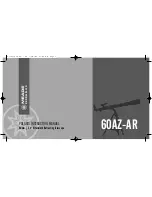
37
Tips and Tricks
If viewing at night, let your eyes “dark-adapt”: Allow five or ten minutes for your eyes to become “dark
adapted” before observing. Use a red filtered flashlight to protect your night vision when reading star
maps, or inspecting the telescope. Stay away from bright lights too. Do not use a regular flash-light or
turn on other lights when observing with a group of other astronomers.
EYEPIECES
Always begin your observations using the 26mm low-power eyepiece. The 26mm eyepiece delivers a
bright, wide field of view and is the best to use for most viewing conditions. Use the high-power 9mm
eyepiece to view details when observing the Moon and planets. If the image becomes fuzzy, switch back
down to a lower power. Changing eyepieces changes the power or magnification of your telescope.
Optional Accessory Barlow lens: You can also change magnification by using a Barlow lens. The Barlow
lens doubles the power of your telescope.
OBJECTS MOVE IN THE EYEPIECE
If you are observing an astronomical object, you will notice that the object will begin to move slowly
through the telescopic field of view. This movement is caused by the rotation of the Earth and makes an
object move through the telescope’s field of view. To keep astronomical objects centered in the field,
simply move the telescope on one or both of its axes—vertically and/or horizontally as needed. At higher
powers, astronomical objects will seem to move through the field of view of the eyepiece more rapidly.
36









































